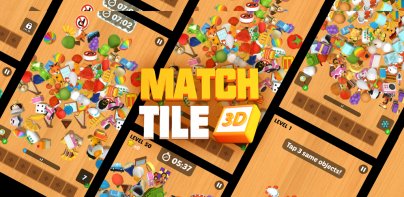


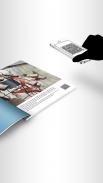
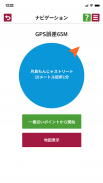
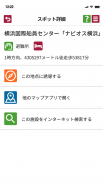
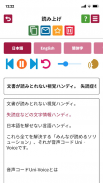
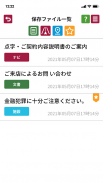
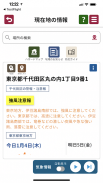
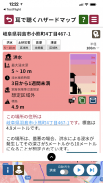
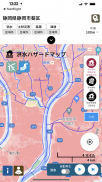
Uni-Voice Blind

Description of Uni-Voice Blind
The Uni-Voice blind app is an app that reads the voice code "Uni-Voice" developed for visually impaired people.
By holding the camera over Uni-Voice, the voice code of printed matter, and taking a picture, you can obtain information about the printed material in Japanese or multilingual translation.
You can also click on the audio code displayed on the website to read it out loud and save it with this app.
●How to use the app
When you start the app, the scan screen will be displayed. Hold your smartphone at a height of about 10 centimeters and project the audio code on the screen.
If the beeping sound becomes faster, please fix it in that position. If the buzzer sounds, please adjust the brightness.
When a voice code is detected, it will automatically take a picture and move to the reading screen.
If you have the screen reader function (Talkback) turned on on your device, the read text will be displayed in the center of the reading screen, so please read it using Talkback by touching or flicking left or right. If Talkback is off, it will be read out automatically.
The notch in the printed material is a guide to the location of the audio code. Change the orientation of the print so that the notch is at the bottom of the right side. The audio code is printed right next to the notch.
The read voice code is saved as a file and can be recalled later from the file list screen.
In addition, the Univoice Blind app receives push notifications from government offices and local governments for people with visual impairments. Please refer to the notification list screen.
The voice code "Uni-Voice" also supports navigation codes that provide route location information to the destination using voice, sound, and vibration, and spot codes that provide information on evacuation sites and tourist facilities.
For other detailed usage information, please refer to the in-app help screen.
●What is the voice code “Uni-Voice”?
The voice code "Uni-Voice" is a two-dimensional barcode compatible with mobile phones that can record approximately 800 characters of character data, developed by JAVIS (Japan Visual Impairment Information Dissemination Support Association).
You can record the audio code with a camera and read out the text data stored in the code and save it. It supports 19 languages including Japanese, and is also unique in that it can be read aloud even without a communication environment.
The Act to Eliminate Discrimination against Persons with Disabilities, which was revised in May 2021, prohibits discrimination against persons with disabilities, and requires not only the national and local governments but also private companies to provide reasonable accommodation for persons with disabilities. .
The voice code "Uni-Voice" has been widely used in recent years, including being adopted for My Number Card notifications and regular regular mail, and is used for printing on paper media such as pamphlets and various envelopes, and as read-aloud content on websites. can.
By utilizing voice codes, the country, local governments, public organizations, and private companies will be able to disseminate information that is accessible to residents, customers, and users who have difficulty reading Japanese.
Click here for more information on Uni-Voice
https://www.uni-voice.co.jp/
●About Uni-Voice for UD
Uni-Voice for UD (Universal Design) utilizes the audio code Uni-Voice to help national and local governments, public organizations, and private companies provide accessible information for residents, customers, and users who have difficulty reading Japanese. A web solution that allows you to send messages.
●What is a website that you can listen to?
One of the main features of Uni-Voice for UD is a "listening website". This is a service that uses information from existing websites to easily create ``listening websites,'' which are Web accessibility-compatible sites that support voice reading for visually impaired people. Since a separate site with a voice code Uni-Voice is created using information from an existing website, 1) there is no need to forcefully mix a regular site and a site for visually impaired people, while 2) it is designed for visually impaired people. It can meet two needs at the same time: creating a website without incurring large costs. Furthermore, it can also be used to (3) convert paper printed matter into audio as electronic pamphlets or electronic catalogs.
Uni-Voice for UD service site https://ud.uni-voice.biz
●First in Japan! The hazard map speaks. Added a hazard map function that you can listen to with your ears.
This hazard map is read aloud on a smartphone and is easy to understand for people with visual impairments and the elderly.
・GPS function automatically reads out hazard risk information for your current location and surrounding area
・Supports risk reading of floods, landslides, storm surges, and tsunamis
・Audio reading of hazard risk information for locations selected on the map or searched locations
・Display hazard risk distribution information on the map
・Display the nearest evacuation site according to the disaster type from your current location, route display, and guidance
- Fully compatible with screen readers (VoiceOver/Talkback)
・Real-time notification of weather forecasts and currently occurring weather warnings and advisories
・Utilize open data from the Geospatial Information Authority of Japan
*Disclaimer*
Depending on the camera performance of the device you are using and the environment where the photo was taken, it may not be possible to read or it may be difficult to read.
Text reading depends on the performance of TTS (speech synthesis).
Additionally, we may not guarantee compatibility with OS versions that did not exist at the time of app release or latest update.
Compatible OS: Android 6.0 or higher

